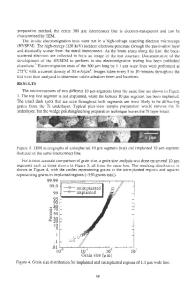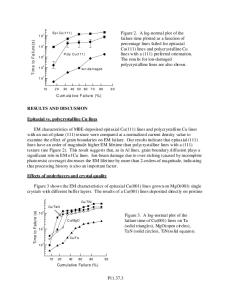Improved Electromigration Lifetime for Copper Interconnects using Tantalum Implant
- PDF / 1,272,325 Bytes
- 6 Pages / 612 x 792 pts (letter) Page_size
- 100 Downloads / 338 Views
0990-B06-06
Improved Electromigration Lifetime for Copper Interconnects using Tantalum Implant Jeff Gambino1, Timothy D. Sullivan1, Jason Gill2, Fen Chen1, Steve Mongeon1, Edward D. Adams1, Jay Burnham1, Phil Pokrinchak1, and Kenneth P. Rodbell3 1 IBM Microelectronics, Essex Junction, VT, 05452 2 IBM Microelectronics, Hopewell Junction, NY, 12533 3 IBM Thomas J. Watson Research Center, Yorktown Heights, NY, 10598
ABSTRACT In this study, a novel method is explored for improving the electromigration lifetime of Cu wires, using Ta implantation into Cu. For high implant doses (2E15 cm-2), the electromigration lifetime is improved by over 5X using this method. An increase in lifetime is achieved, even for an average surface concentration of Ta on the order of 0.1 atm%. We propose that the improvement in electromigration lifetime is due to the reduction of defects at the SiN/Cu interface due to the presence of Ta. The line-to-line leakage at high voltages (> 5V) increases with the Ta implant, with higher leakage at higher Ta concentrations, so the Ta dose must be limited to avoid excessive leakage. INTRODUCTION Copper interconnects have gained wide acceptance in the microelectronics industry due to improved resistivity and reliability compared to Al interconnects [1]. However, as devices become smaller, the current density through the interconnects increases [2], requiring a longer electromigration lifetime. Refractory metal capping layers can significantly improve the electromigration lifetime of Cu interconnects [3-6]. The electromigration lifetime for Cu interconnects is determined by the mass transport at the interface between Cu and the capping layer, and can be improved by increasing the adhesion between these layers [4]. The adhesion is higher for metal capping layers compared to dielectric capping layers, resulting in a longer electromigration lifetime. Two basic approaches have been reported for making refractory metal capping layers on Cu; blanket metal deposition on a recessed Cu line, followed by chemical mechanical polishing (CMP), or selective metal deposition using electroless plating or chemical vapor deposition (CVD). Although a large improvement in electromigration lifetime can be achieved with metal capping layers, the process is difficult to implement, due to additional cost, increased resistivity of the Cu wires, or reduced reliability of the dielectric. In this study, a novel method is explored for improving the electromigration lifetime of Cu wires, using Ta implantation into Cu. The electromigration lifetime is improved by over 3X using this method, with a minimal increase in wire resistance. However, the line-to-line leakage at high voltages (> 5V) increases with the Ta implant, which may limit the application of this method.
EXPERIMENT
SiN1 M2 FTEOS 1. M2 CMP + thin SiN cap Ta FTEOS 2. Ta implant SiN2 FTEOS 3. Deposit SiN2
Fig. 1. Schematic of sample preparation. RESULTS
Concentration (x1020 cm-3)
Samples were fabricated using a 0.13 µm CMOS process with via-first dual damascene Cu in an
Data Loading...











